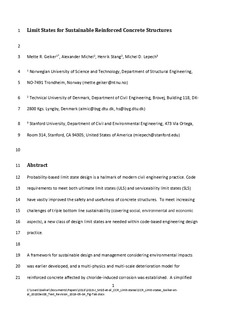| dc.contributor.author | Geiker, Mette Rica | |
| dc.contributor.author | Michel, Alexander | |
| dc.contributor.author | Stang, Henrik | |
| dc.contributor.author | Lepech, Michael | |
| dc.date.accessioned | 2019-06-03T06:06:20Z | |
| dc.date.available | 2019-06-03T06:06:20Z | |
| dc.date.created | 2019-06-01T16:51:38Z | |
| dc.date.issued | 2019 | |
| dc.identifier.citation | Cement and Concrete Research. 2019, 122 189-195. | nb_NO |
| dc.identifier.issn | 0008-8846 | |
| dc.identifier.uri | http://hdl.handle.net/11250/2599602 | |
| dc.description.abstract | Probability-based limit state design is a hallmark of modern civil engineering practice. Code requirements to meet both ultimate limit states (ULS) and serviceability limit states (SLS) have vastly improved the safety and usefulness of concrete structures. To meet increasing challenges of triple bottom line sustainability (covering social, environmental and economic aspects), a new class of design limit states are needed within code-based engineering design practice.
A framework for sustainable design and management considering environmental impacts was earlier developed, and a multi-physics and multi-scale deterioration model for reinforced concrete affected by chloride-induced corrosion was established. A simplified case study is presented in which a reinforced concrete panel is exposed to a marine environment. The multi-physics deterioration model is used to determine the time until an engineering limit state (cracking due to reinforcement corrosion) is reached, and a design and maintenance optimization is performed with regard to sustainability (global warming potential footprint). | nb_NO |
| dc.language.iso | eng | nb_NO |
| dc.publisher | Elsevier | nb_NO |
| dc.rights | Attribution-NonCommercial-NoDerivatives 4.0 Internasjonal | * |
| dc.rights.uri | http://creativecommons.org/licenses/by-nc-nd/4.0/deed.no | * |
| dc.title | Limit states for sustainable reinforced concrete structures | nb_NO |
| dc.type | Journal article | nb_NO |
| dc.type | Peer reviewed | nb_NO |
| dc.description.version | acceptedVersion | nb_NO |
| dc.source.pagenumber | 189-195 | nb_NO |
| dc.source.volume | 122 | nb_NO |
| dc.source.journal | Cement and Concrete Research | nb_NO |
| dc.identifier.doi | 10.1016/j.cemconres.2019.04.013 | |
| dc.identifier.cristin | 1702061 | |
| dc.description.localcode | © 2019. This is the authors’ accepted and refereed manuscript to the article. Locked until 20 May 2021 due to copyright restrictions. This manuscript version is made available under the CC-BY-NC-ND 4.0 license http://creativecommons.org/licenses/by-nc-nd/4.0/ | nb_NO |
| cristin.unitcode | 194,64,45,0 | |
| cristin.unitname | Institutt for konstruksjonsteknikk | |
| cristin.ispublished | true | |
| cristin.fulltext | postprint | |
| cristin.qualitycode | 2 | |

